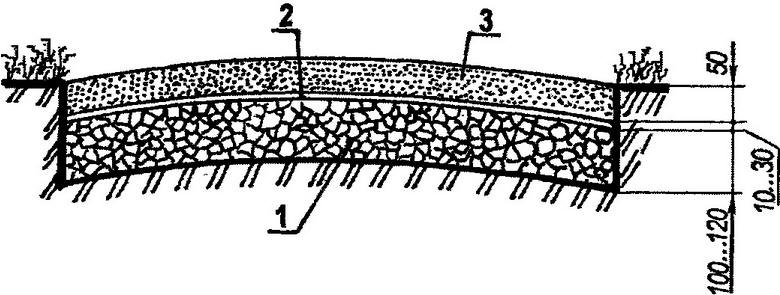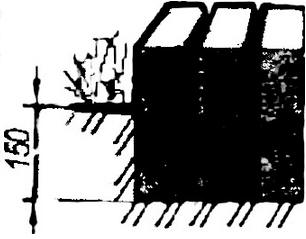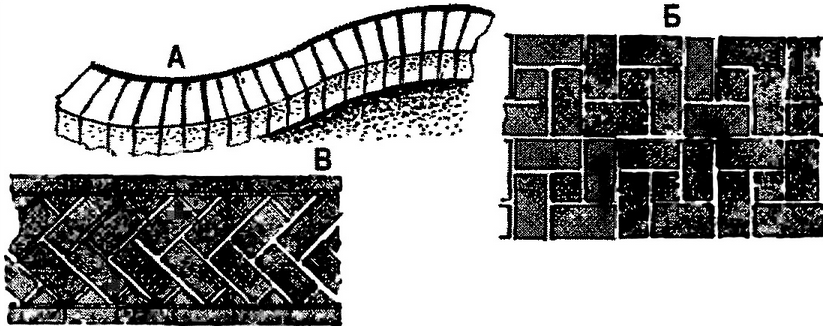
|
|
BUILDER, HOUSEHOLDER
Garden paths. Tips for the home master
Directory / Builder, home master Specially laid garden paths go well with a green lawn and plantings at their summer cottage. From the gate or gate to the house, they are usually short and wide enough for two people to pass: about 1,5 m. And the paths to the garden and places of rest can be narrow and meander picturesquely around the site, decorating it. Bulk paths The simplest at first glance, the paths are made of crushed stone or gravel. Usually it is a small crumb of granite or building stone, brick. It can simply be poured into a shallow, extended bed dug in the ground and lightly rammed. However, such a path will last longer if the so-called pillow is laid under this layer - a thick layer of broken brick or pebbles. The gravel path looks beautiful also because it turns out to be colored. It does not retain precipitation, dries quickly after rain and will not be slippery in icy conditions. But its disadvantages include the fact that its small fractions, especially when wet, eventually spread with shoes throughout the site, striving to get into the house, which is not very desirable.
slab walkway Paving from ready-made slabs is best suited for paths, which must have a thickness of at least 6 cm. In this case, the material must be chosen very carefully, both from an aesthetic and practical point of view. The finished tile of sandy yellow or ocher color is most suitable for the greenery of the lawn; too light glare unpleasantly in the bright sun. Natural tiles should have a rough, rough surface so that the path does not become slippery in rainy weather or ice. Since it is difficult to lay small tiles tightly enough, it is desirable that their dimensions are not smaller than 300x300 mm. Tiles are also convenient in that they can be laid directly on the sand, and in the busiest places in the garden - on cement mortar laid on a layer of gravel 100-200 mm thick. Each tile needs to be lightly tapped with a hammer so that it "sits" securely in the underlayer.
The gaps between the stone tiles should be made as narrow as possible. If tiles of different sizes are laid, then their alternation should be the same. On the edges of the road it is better to use larger material. With the help of a long board and a level, it is necessary to constantly check during work whether the tiles lie horizontally. The gaps between them must be filled with liquid cement, to which, if desired, you can add a little paint. The surface of such a road should have a two-degree slope. Paths made of bricks Usually, for these purposes, the so-called burnt brick is preferred, and along with the whole, broken brick is also used, which serves to fill gaps or participate in the creation of patterned masonry. To lay out a brick path, you must first mark out its direction and dimensions, then remove the soil layer to a depth corresponding to the height of the brick placed on its side. Along the edges, with the help of small pegs, the future path is edged with wooden boards with a section of 50x150 mm, mounted on the edge. Separating the path according to the intended dimensions, we install it along the edges of the board, spreading them with spacer bars every 1,2 - 1,6 m. the other side so that when it rains, water does not linger. In the longitudinal direction, the path should also have a slight slope.
Brick laying without a pillow The bottom of the prepared trench is covered with crushed stone or stone chips so that the bricks are flush with the edging boards. The gravel layer is leveled to the desired level using a wooden plank moved along the spacer bars at the appropriate depth along the side boards. When this sublayer is finally leveled, you can proceed to the brickwork. You can arrange the bricks in a variety of ways, installing them on either side, but as close as possible to each other. If it is desirable to leave gaps for the germination of grass, then they must be filled with sand and thoroughly watered for compaction. After laying, to prevent displacement of bricks, the gaps in the masonry can be covered with fine sand.
Asphalt paths Recently, asphalt has been used quite often for laying paths in the garden. For such a path, you first need to prepare a fairly solid base with a thickness of 100 - 250 mm, on which stone chips filled with asphalt should be poured, leveled and tamped while still warm. The final layer of asphalt should be 30 mm thick. You can also use colored asphalts, which are laid in a cold state.
Not a stone, but a tree The path paved with wooden bars looks very nice, but it is not suitable for places that are too damp. The bars must be at least 200 mm high. You can use any type of wood, but, of course, hardwoods will be stronger. In order for such a track to serve as long as possible, before laying, each bar must be dipped in a special impregnating compound or fuel oil, and then allowed to dry properly. The lower part of the bar can also be dipped into liquid asphalt. So that the wood does not rot, it is laid on a sandy substrate. We must try to arrange the individual bars in such a way that the wider ones and those that are narrower alternate harmoniously; then the whole masonry will look more beautiful. Along the edges it is better to lay bars with a larger surface. The finished coating must be covered with sand and thoroughly poured with water so that the sand fills all the cracks.
Machine for thinning flowers in gardens
02.05.2024 Advanced Infrared Microscope
02.05.2024 Air trap for insects
01.05.2024
▪ Greenlanders came from Siberia ▪ The most dangerous predator on the planet ▪ Microrobots of Swiss watchmakers
▪ section of the site Electrician in the house. Article selection ▪ article In the main - unity, in the secondary - freedom, in everything - love. Popular expression ▪ article Where is the largest Christian church located? Detailed answer ▪ article storekeeper. Standard instruction on labor protection ▪ article Knot on a rope. Focus Secret
Home page | Library | Articles | Website map | Site Reviews www.diagram.com.ua |






 Arabic
Arabic Bengali
Bengali Chinese
Chinese English
English French
French German
German Hebrew
Hebrew Hindi
Hindi Italian
Italian Japanese
Japanese Korean
Korean Malay
Malay Polish
Polish Portuguese
Portuguese Spanish
Spanish Turkish
Turkish Ukrainian
Ukrainian Vietnamese
Vietnamese







 See other articles Section
See other articles Section 